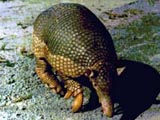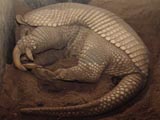Giant armadillo
One species of giant armadillo (P. maximus) is recognized. The giant armadillo is the largest armadillo species.
Priodontes maximus
Giant Armadillo
- Range:
South America east of the Andes, central Venezuela to northeastern Argentina.
- Size and Weight:
Head and body length: 75 — 100 cm (29.5 — 39.4 in).
Tail length: 50 cm (19.7 in).
Weight: Up to 60 kg (132 lbs) in captivity; reported field weights from 18.7 — 32.3 kg (41.2 — 71.2 lbs).- Description:
P. maximus has scant hairs, and is generally dark brown with a white band on the edge of the shell. There are 11 to 13 movable bands on the shell, and 3 to 4 on the back of the neck. The carapace is very flexible. P. maximus possesses large claws on the forefeet; the largest one, found on the 3rd toe, measures 203 mm along the curve. These animals are remarkably different from the standard mammalian tooth pattern, possessing up to 100 teeth, which are shed as the animal ages. Females have two mammae.
- Habitat:
Reported to live primarily in unbroken, undisturbed forest, near water; however, one study in Brazil found 68% of burrows in grassland, 28% in brushland and only 3% in forested areas. Half the burrows in the study were found in active termite mounds. The minimum home range is reported as 452.5 ha (1118.2 acres).
- Ecology:
Primarily nocturnal. P. maximus can balance on the tail and hind legs to reach higher up termite mounds when foraging. Because of the animals size, it cannot conceal its underparts under its shell, and as a result, primarily digs as an escape mechanism. P. maximus eats primarily termites, but also includes ants and other insects, spiders, worms, larvae, carrion, and snakes. The animal is often accused of eating crops or garden vegetables, but is probably just foraging for insect food in the soft soil.
Listed as endangered by the IUCN (50% of the population has been lost within the last ten years), endangered by the USDI (1980), and is listed on appendix 1 of the CITES. P. maximus is threatened by overhunting due to its popularity as a food item. The animal does not do well in close contact with humans.
- Biology:
Gestation period is 4 months. One or two young are born at a time, with tough, leathery skin. Young are weaned at 4 — 6 weeks, and are sexually mature at 9 — 12 months. The lifespan is reported as 12 — 15 years.
- Pictures:
-
Do you have a picture of P. maximus that you would like to donate to this site? Please see the Armadillos Wanted page to see how you can help.
Sources
Nowak, R.M. 1999. Walker’s Mammals of the World, 6th edition. Johns Hopkins University Press, Baltimore, MD. 158-168.
Abbreviations
IUCN: International Union for Conservation of Nature and Natural Resources
USDI: United States Department of the Interior
CITES: Convention on International Trade in Endangered Species of Wild Fauna and Flora
 ] will leave this website.
] will leave this website.


